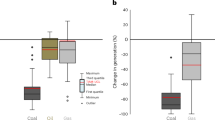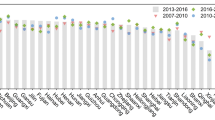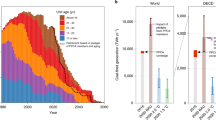Abstract
Economic development in sub-Saharan Africa has increased carbon emissions and will continue to do so. However, changes in emissions in the past few decades and their underlying drivers are not well understood. Here we use a Kaya decomposition to show that rising carbon intensity has played an increasingly important role in emission growth in sub-Saharan Africa since 2005. These changes have mainly been driven by the increasing use of oil, especially in the transportation sector. Combining investment data in the power sector with economic and population projections, we find that investments in new coal-fired capacity may become a major driver of future carbonization. Our results highlight the importance of making low-carbon technologies available and financially attractive to sub-Saharan African countries to avoid a lock-in of emission-intensive energy use patterns.
This is a preview of subscription content, access via your institution
Access options
Access Nature and 54 other Nature Portfolio journals
Get Nature+, our best-value online-access subscription
$29.99 / 30 days
cancel any time
Subscribe to this journal
Receive 12 print issues and online access
$209.00 per year
only $17.42 per issue
Buy this article
- Purchase on Springer Link
- Instant access to full article PDF
Prices may be subject to local taxes which are calculated during checkout




Similar content being viewed by others
Data availability
The data used in this study are not publically available (except Shearer et al.22 and Wirth34). Data on emissions and energy are available from the IEA15, and data on power plants are available from Platts16, but fees and restrictions apply to the availability of both databases that we used under license for the current study. Data are available from the authors on reasonable request and with permission of the IEA and Platts, respectively. Data on SSP scenarios rely on peer reviewed publications and are available from the respective modelling teams23,24,25,26,27,28.
Code availability
All code and figures and their underlying data are available at https://github.com/jhilaire/ssawosacarb.git
References
IPCC Climate Change 2014: Mitigation of Climate Change (eds Edenhofer, O. et al.) (Cambridge Univ. Press, 2014).
Steckel, J. C., Edenhofer, O. & Jakob, M. Drivers for the renaissance of coal. Proc. Natl Acad. Sci. USA 112, E3775–E3781 (2015).
Davis, S. J. & Socolow, R. H. Commitment accounting of CO2 emissions. Environ. Res. Lett. 9, 084018 (2014).
Edenhofer, O., Steckel, J. C., Jakob, M. & Bertram, C. Reports of coal’s terminal decline may be exaggerated. Environ. Res. Lett. 13, 024019 (2018).
Peters, G. P. et al. Key indicators to track current progress and future ambition of the Paris Agreement. Nat. Clim. Change 7, 118–122 (2017).
Jackson, R. B. et al. Warning signs for stabilizing global CO2 emissions. Environ. Res. Lett. 12, 110202 (2017).
Akinlo, A. E. Energy consumption and economic growth: evidence from 11 sub-Sahara African countries. Energy Econ. 30, 2391–2400 (2008).
Kebede, E., Kagochi, J. & Jolly, C. M. Energy consumption and economic development in sub-Sahara Africa. Energy Econ. 32, 532–537 (2010).
Wolde-Rufael, Y. Energy demand and economic growth: the African experience. J. Policy Model. 27, 891–903 (2005).
Wolde-Rufael, Y. Energy consumption and economic growth: the experience of African countries revisited. Energy Econ. 31, 217–224 (2009).
Lucas, P. L. et al. Future energy system challenges for Africa: insights from integrated assessment models. Energy Policy 86, 705–717 (2015).
Calvin, K., Pachauri, S., De Cian, E. & Mouratiadou, I. The effect of African growth on future global energy, emissions, and regional development. Climatic Change 136, 109–125 (2016).
van der Zwaan, B., Kober, T., Longa, F. D., van der Laan, A. & Jan Kramer, G. An integrated assessment of pathways for low-carbon development in Africa. Energy Policy 117, 387–395 (2018).
Leimbach, M., Roming, N., Schultes, A. & Schwerhoff, G. Long-term development perspectives of sub-Saharan Africa under climate policies. Ecol. Econ. 144, 148–159 (2018).
World Energy Balances (IEA, 2017).
World Electric Power Plants Database (Platts, 2017).
Riahi, K. et al. The shared socioeconomic pathways and their energy, land use, and greenhouse gas emissions implications: an overview. Glob. Environ. Change 42, 153–168 (2017).
Kaya, Y. in Response Strategies Working Group, Energy and Industry Subgroup (IPCC, 1989).
Tilman, D. et al. Beneficial biofuels—the food, energy, and environment trilemma. Science 325, 270–271 (2009).
Cherubini, F., Peters, G. P., Berntsen, T., StrøMman, A. H. & Hertwich, E. CO2 emissions from biomass combustion for bioenergy: atmospheric decay and contribution to global warming. GCB Bioenergy 3, 413–426 (2011).
Summary Statistics: Coal Plants by Country (MW) July 2019 (Global Coal Plant Tracker, 2019).
Shearer, C., Mathew-Shaw, N., Myllyvirta, L., Yu, A. & Nace, T. Boom and Bust 2018: Tracking the Global Coal Plant Pipeline (2018); http://endcoal.org/wp-content/uploads/2018/03/BoomAndBust_2018_r4.pdf
van Vuuren, D. P. et al. Energy, land-use and greenhouse gas emissions trajectories under a green growth paradigm. Glob. Environ. Change 42, 237–250 (2017).
Fricko, O. et al. The marker quantification of the Shared Socioeconomic Pathway 2: a middle-of-the-road scenario for the 21st century. Glob. Environ. Change 42, 251–267 (2017).
Fujimori, S. et al. SSP3: AIM implementation of shared socioeconomic pathways. Glob. Environ. Change 42, 268–283 (2017).
Calvin, K. et al. The SSP4: a world of deepening inequality. Glob. Environ. Change 42, 284–296 (2017).
Kriegler, E. et al. Fossil-fueled development (SSP5): an energy and resource intensive scenario for the 21st century. Glob. Environ. Change 42, 297–315 (2017).
Bauer, N. et al. Shared socio-economic pathways of the energy sector—quantifying the narratives. Glob. Environ. Change 42, 316–330 (2017).
Jakob, M. & Steckel, J. C. How climate change mitigation could harm development in poor countries. WIREs Clim. Change 5, 161–168 (2014).
McCollum, D. L. et al. Connecting the sustainable development goals by their energy inter-linkages. Environ. Res. Lett. 13, 033006 (2018).
Sun, J. W. & Ang, B. W. Some properties of an exact energy decomposition model. Energy 25, 1177–1188 (2000).
Ang, B. W. Decomposition analysis for policymaking in energy: which is the preferred method? Energy Policy 32, 1131–1139 (2004).
Steckel, J. C., Jakob, M., Marschinski, R. & Luderer, G. From carbonization to decarbonization? Past trends and future scenarios for China’s CO2 emissions. Energy Policy 39, 3443–3455 (2011).
Wirth, H. Recent Facts about Photovoltaics in Germany (Fraunhofer ISE, 2018); https://www.ise.fraunhofer.de/en/publications/studies/recent-facts-about-pv-in-germany.html
IPCC 2006 IPCC Guidelines for National Greenhouse Gas Inventories (eds Eggleston, H. S. et al.) (Institute for Global Environmental Strategies, 2006).
Acknowledgements
The authors acknowledge funding from the German Federal Ministry of Education and Research (BMBF), funding code 011A1807A (DECADE). We also thank K. Calvin (PNNL), N. Bauer (PIK), D. van Vuuren and M. Hamsen (PBL), S. Fujimori (NIES) and O. Fricko (IIASA) for sharing IAM data with us. We thank L. Montrone and L. M. Puerto Chaves for excellent research assistance.
Author information
Authors and Affiliations
Contributions
All authors conceived and planned the project. J.C.S., J.H. and M.J. analysed the data. J.H., J.C.S. and M.J. designed the simulations. J.H. and J.C.S. developed the code and ran the simulations. J.C.S, M.J. and J.H. wrote the paper.
Corresponding author
Ethics declarations
Competing interests
The authors declare no competing interests.
Additional information
Peer review information Nature Climate Change thanks Fadiel Ahjum, Heli Arminen, Paul Lucas and the other, anonymous, reviewer(s) for their contribution to the peer review of this work.
Publisher’s note Springer Nature remains neutral with regard to jurisdictional claims in published maps and institutional affiliations.
Supplementary information
Supplementary Information
Supplementary Figs. 1–8, Tables 1–5 and detailed descriptions of data and methods.
Rights and permissions
About this article
Cite this article
Steckel, J.C., Hilaire, J., Jakob, M. et al. Coal and carbonization in sub-Saharan Africa. Nat. Clim. Chang. 10, 83–88 (2020). https://doi.org/10.1038/s41558-019-0649-8
Received:
Accepted:
Published:
Issue Date:
DOI: https://doi.org/10.1038/s41558-019-0649-8
This article is cited by
-
The narrowing gap in developed and developing country emission intensities reduces global trade’s carbon leakage
Nature Communications (2023)
-
The cost of electrifying all households in 40 Sub-Saharan African countries by 2030
Nature Communications (2023)
-
Energizing environmental sustainability in Sub-Saharan Africa: the role of governance quality in mitigating the environmental impact of energy poverty
Environmental Science and Pollution Research (2023)
-
Balancing national economic policy outcomes for sustainable development
Nature Communications (2022)
-
Beyond COP26: can income level moderate fossil fuels, carbon emissions, and human capital for healthy life expectancy in Africa?
Environmental Science and Pollution Research (2022)



